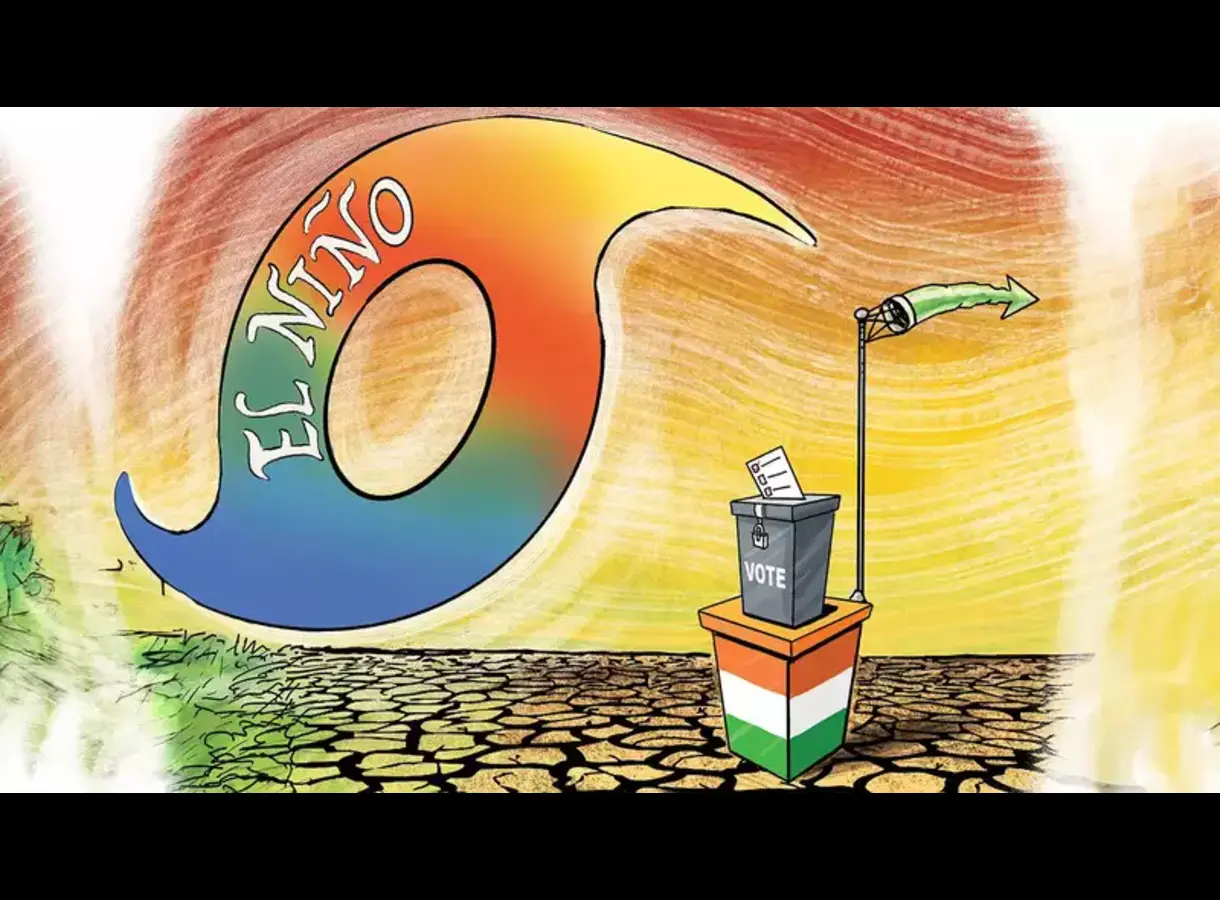This article originally appeared in The Times of India
El Nino is likely affecting rains. From colonial times, this weather phenomenon has strongly shaped India’s political-economy. How it will impact 2023-24’s many elections will depend on govt response:

As forecasts from the National Oceanic Atmospheric Administration (NOAA) of the US and the World Meteorological Organisation (WMO) signal the arrival of El Niño, it’s clear that India faces more than mere climatic changes. This weather phenomenon, infamous for its ability to warm the climate and disrupt weather patterns, could significantly reshape India’s political landscape.
El Niño has had a significant impact on the economic and political history of India. In fact, the overlap between El Niño years and the social and political development in the country is astounding and uncannily consistent.
Historically, El Niño has correlated with severe dry spells and droughts in the Indian subcontinent, often leading to diminished summer monsoon crop yields. During the British Raj, a combination of El Niño-induced droughts and colonial government mismanagement resulted in devastating famines that killed millions. The Great Famine of 1876–1878 and 1899-1900, which together claimed more than 10 million lives, coincided with strong El Niño years. These events, in turn, significantly influenced the anti-colonial movement in the country. For example, the famine of 1876-77 triggered the first substantial economic critique of the colonial government by Dadabhai Naoroji and Romesh Chunder Dutt. It also prompted William Wedderburn and A. O. Hume to establish the Indian National Congress, providing a platform for Indians to voice their opinions on government policies such as those related to drought management. Similarly, the El Niño-induced drought of 1918 led to the Kheda Satyagraha, which elevated Mahatma Gandhi’s profile and made Sardar Patel a household name in the country. There are numerous such examples, and one can trace many more significant events in the independence movement to El Niño.
El Niño’s influence has continued to shape the political and economic landscape of post-independence India as well. The most notable agricultural development– the Green Revolution – was triggered by the devastating droughts of 1964–65 and 1965–66. Likewise, the tumultuous period of 1976-1980, which saw the downfall of Indira Gandhi, the formation of the Janata Party government, and the fall of Morarji Desai’s and Charan Singh’s governments, all unfolded during the El Niño years. The 1979 El Niño was so devastating that it caused a once-in-a-century drought and contracted the Indian economy by more than 5%. The fallout of this political upheaval was the founding of the BJP in 1980, which successfully challenged Congress and came to power within two decades. In many ways, the India in which we live today was created in 1979. The question is: what kind of impacts will the 2023-24 El Niño have?
Firstly, the monsoon has arrived late and we have so far experienced a 51% deficit in rainfall. As El Niño has already developed in May-June, the second half of the monsoon will likely witness lower rainfall, as has been the trend in the past. Overall, it is becoming clear that we will not have a “normal” monsoon this year, despite the forecast of the Indian Meteorological Department (IMD). In fact, the Laboratory for Experimental Hydroclimate Prediction at the University of Maryland has forecasted a significant shortfall in rains during June-September, especially in North-West and South India.
Second, El Niño in combination with global warming is predicted to hit record-high temperatures. This means that the winter of 2023 could be warmer than usual, which could impact wheat production. India is already bearing the brunt of higher temperatures and heatwaves on wheat. During 2022, the record heatwaves in February and March reduced wheat production by close to 5 million tonnes. If temperatures rise even higher during 2023-24, the impacts on wheat production could be even greater. In addition, higher temperatures will exacerbate heatwave impacts and put immense pressure on electricity grid and health infrastructure.
Lastly, if El Niño persists, as it often does for more than a year, the 2024 Kharif crops could be at risk as well. So, El Niño could potentially impact three consecutive cropping seasons. The important point is that all these seasons coincide with a critical election period in India. Over the next 12 months, India will witness nine state elections, and the general elections slated for April-May, 2024. These elections could well see the effects of El Niño subtly shaping voter sentiments. This wouldn’t be the first time such a thing would have happened as there is a long history of weather and agricultural outcomes swaying political fortunes in India.
However, while the possibility of El Niño influencing election outcomes is real, it is just one of many variables that will shape the political landscape in the coming months. Economic performance, political alliances, leadership, and social issues will also have significant sway.
Note that not all El Niño induced severe droughts have resulted in political upheaval. Effective governmental responses to these challenges have often mitigated their impacts. For instance, despite severe droughts during 1982-83 and 2015-16, governments under the leadership of Indira Gandhi and Narendra Modi, respectively, managed to alleviate the adverse effects. Therefore, the government’s response to the challenges posed by El Niño could be a critical determinant of public perception and voting patterns.
Weather, indeed, has always played an important role in shaping the political fate of India. With the arrival of El Niño, 2023-24 promises to be a pivotal year where climate and politics intertwine, as never in independent India’s history so many elections have coincided with an El Niño year. How effectively politics respond to these challenges and how voters react will shape the climate change actions in the country in the years to come.
Chandra Bhushan is one of India’s foremost public policy experts and the founder-CEO of International Forum for Environment, Sustainability & Technology (iFOREST).
